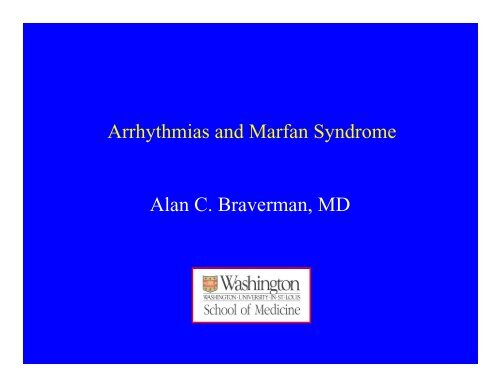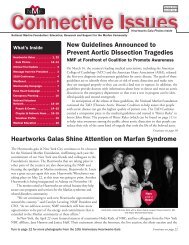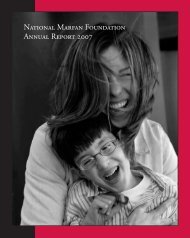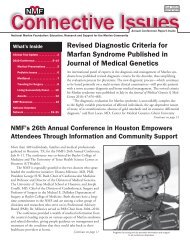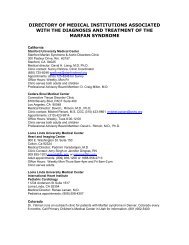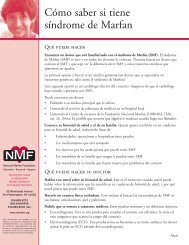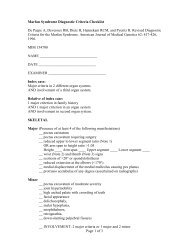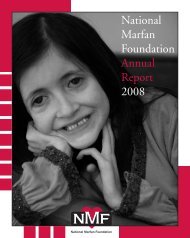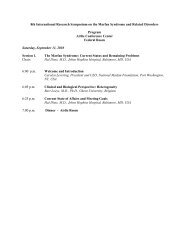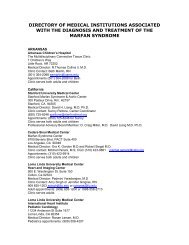Arrhythmias and Marfan Syndrome Alan C. Braverman, MD
Arrhythmias and Marfan Syndrome Alan C. Braverman, MD
Arrhythmias and Marfan Syndrome Alan C. Braverman, MD
Create successful ePaper yourself
Turn your PDF publications into a flip-book with our unique Google optimized e-Paper software.
<strong>Arrhythmias</strong> <strong>and</strong> <strong>Marfan</strong> <strong>Syndrome</strong><br />
<strong>Alan</strong> C. <strong>Braverman</strong>, <strong>MD</strong>
Cardiovascular System in <strong>Marfan</strong> <strong>Syndrome</strong>
Major Criteria:<br />
Cardiovascular Manifestations of the<br />
<strong>Marfan</strong> <strong>Syndrome</strong><br />
• dilatation of the ascending aorta with or without aortic<br />
regurgitation <strong>and</strong> involving at least the sinuses of Valsalva; or<br />
• dissection of the ascending aorta
Minor Criteria:<br />
Cardiovascular Manifestations<br />
• mitral valve prolapse with or without mitral valve regurgitation<br />
• dilatation of the main pulmonary artery in the absence of valvular<br />
or peripheral pulmonic stenosis or any other obvious cause,<br />
below the age of 40 years<br />
• calcification of the mitral annulus below the age of 40 years; or<br />
• dilatation or dissection of the descending thoracic or abdominal<br />
aorta before the age of 50 years.<br />
For the cardiovascular system to be involved a major criterion or<br />
only 1 of the minor criteria must be present.
Cardiac <strong>Arrhythmias</strong>
Normal Electrocardiogram
Common Cardiac <strong>Arrhythmias</strong><br />
1. Premature beats (PAC’s, PVC’s)<br />
2. Atrial arrhythmias<br />
1. Supraventricular tachycardia (SVT)<br />
2. Atrial fibrillation<br />
3. Atrial flutter<br />
4. WPW<br />
3. Ventricular arrhythmias<br />
1. Ventricular tachycardia<br />
2. Ventricular fibrillation<br />
4. Long QT syndromes<br />
5. Bradyarrhythmias
• Pulse monitoring<br />
Methods to Evaluate for <strong>Arrhythmias</strong><br />
• Electrocardiogram<br />
• 24 Hour Ambulatory ECG-Monitor (Holter)<br />
• Event Recorder (event, loop, implantable)<br />
• Electrophysiology Study
Why Might a Person with <strong>Marfan</strong> <strong>Syndrome</strong><br />
Develop an Arrhythmia?<br />
1. Unrelated to <strong>Marfan</strong> <strong>Syndrome</strong><br />
Arrhythmia with a Normal Heart<br />
• caffeine, alcohol, stress, anxiety, lack of sleep, stimulants<br />
• Electrolyte abnormalities (low K + , low Mg ++ )<br />
Arrhythmia with Underlying Heart Disease<br />
• HTN, CAD, Cardiomyopathy, CHF<br />
• Conduction disease<br />
• Valvular heart disease
Why Might a Person with <strong>Marfan</strong> <strong>Syndrome</strong><br />
Develop an Arrhythmia?<br />
2. Related to <strong>Marfan</strong> <strong>Syndrome</strong><br />
Valvular Heart Disease<br />
• Mitral valve prolapse<br />
• Mitral regurgitation<br />
• Aortic insufficiency<br />
Post-operative <strong>Arrhythmias</strong><br />
Cardiomyopathy/CHF
PVC’s<br />
1. Premature Contractions<br />
Types of <strong>Arrhythmias</strong><br />
1. “premature beats, skipped beats, missed beats, early beats”<br />
2. The heart is prematurely electrically stimulated interrupting the<br />
normal conduction pattern<br />
PAC’s<br />
Symptoms: Palpitations, strong beat, fullness in neck, sense of the<br />
heart stopping, missed beat or pause
• Precipitants<br />
Premature Contractions<br />
Caffeine, alcohol<br />
Lack of sleep<br />
Anxiety, stress<br />
Stimulants<br />
• Treatment<br />
Underlying Heart Disease<br />
Evaluate for underlying cause or heart disease<br />
Remove or treat precipitants<br />
Reassurance<br />
Beta-Blocker
Supraventricular Tachycardia (SVT)<br />
Rapid, regular tachycardia with heart rate 150-225 bpm<br />
Most common: AV nodal reentry tachycardia<br />
Symptoms: palpitations, heart racing, lightheadedness, SOB, chest<br />
pain<br />
Mechanism: Premature beat<br />
Leads to reentry circuit in AV node
Supraventricular Tachycardia<br />
May occur in a normal heart or with underlying heart disease<br />
More common in mitral valve prolapse<br />
• Evaluation:<br />
• Treatment:<br />
Examine heart function (echocardiogram)<br />
Search for precipitants<br />
Vagal maneuvers<br />
Drug therapy (Beta-blockers, Calcium channel blockers, digoxin)<br />
EPS-guided treatment (RF modification of AV node)<br />
95% cure rate
Atrial Fibrillation<br />
• Rapid, irregular fibrillatory waves in the atria which<br />
leads to an irregular, chaotic heart rhythm<br />
• Usually precipitated by underlying cardiac disease or<br />
noncardiac disease<br />
Electrical mechanism:<br />
Multiple, small reentrant circuits constantly arising in the atria<br />
Rapidly firing focus (foci) located near the pulmonary veins
Atrial Fibrillation<br />
• Incidence is Age-dependent<br />
Doubles with each decade of adult life<br />
2-3/1000 population per year age 55-64<br />
35/1000 population per year age 85-94<br />
• Results in loss of atrial contribution to ventricular filling<br />
May decrease cardiac performance by 10-30%<br />
• Clinical: Asymptomatic Severe symptoms<br />
palpitations: fluttering, racing, chaotic heart action<br />
fatigue, SOB, chest pain, embolism, stroke
• Etiology:<br />
• Evaluation:<br />
Atrial Fibrillation<br />
1. Underlying heart disease (HTN, CAD, Valvular heart<br />
disease, Cardiomyopathy, CHF, post-operative)<br />
2. Systemic disease (Pulmonary disease, pneumonia)<br />
3. Hyperthyroidism, electrolyte abnormalities<br />
4. Alcohol excess<br />
1. Treat underlying etiology<br />
2. Echocardiogram, Thyroid tests, Other cardiac testing
Risks of Atrial Fibrillation:<br />
Atrial Fibrillation<br />
1. Increased HR: May lead to heart muscle weakness; angina<br />
2. Systemic Embolism: Abnormal atrial contraction leads to<br />
stasis of blood <strong>and</strong> blood clotting
Treatment:<br />
Atrial Fibrillation<br />
1. Control heart rate (beta-blocker, calcium channel<br />
blocker, digoxin)<br />
2. Anticoagulate with warfarin (ASA in selected<br />
patients)<br />
3. Cardioversion<br />
4. Anti-arrhythmic drug therapy<br />
propafenone, sotalol, flecainide, amiodarone<br />
5. EPS-guided therapy<br />
Pulmonary vein isolation, RF ablation, pacemaker<br />
6. Surgical therapy<br />
Cox-Maze procedure, PV isolation
Ventricular <strong>Arrhythmias</strong><br />
Premature Ventricular Contractions<br />
(PVC’s, VPC’s,)<br />
• common<br />
• may occur in a normal heart or with heart disease<br />
• symptoms of “skipped beat” or “missed beat”<br />
• Evaluate for underlying heart disease or precipitant<br />
• When assoc. with a normal heart, generally benign<br />
• Occasionally treated with beta-blocker
Ventricular Tachycardia<br />
• HR > 100 (usually 150-250 bpm)<br />
• Sx: palpitation, SOB, CP, syncope<br />
• May lead to sudden death<br />
Etiology: Underlying Heart Disease (CAD, MI, CHF/CMP)<br />
Rarely related to MVP; Long QT syndromes<br />
Treatment: Drug Rx: beta-blocker/anti-arrhythmic drugs<br />
AICD<br />
RF ablation
Other <strong>Arrhythmias</strong><br />
1. Wolff-Parkinson-White <strong>Syndrome</strong> (WPW)<br />
Accessory bypass tract leads to reentrant arrhythmias<br />
Treated by EPS-guided RF ablation of bypass tract<br />
2. Long QT syndromes<br />
Abnormalities of depolarization <strong>and</strong> repolarization.<br />
Torsades de Pointes<br />
Causes: drugs (anti-arrhythmic, psychotropic), metabolic, Other<br />
3. Bradycardia/Bradyarrhythmias<br />
Slow heart rate, conduction disease, heart block<br />
May be secondary to medications, underlying conduction disease,<br />
May occur after heart surgery<br />
Treatment may require pacemaker
Mitral Valve Prolapse <strong>and</strong> <strong>Arrhythmias</strong><br />
1. MVP occurs in 3-5% of general population<br />
2. MVP occurs in >60% of people with the<br />
<strong>Marfan</strong> syndrome<br />
3. Vast majority of people with MVP are<br />
asymptomatic
• Click <strong>and</strong> Murmur<br />
“Mitral Valve Prolapse <strong>Syndrome</strong>”<br />
• Non-Specific Symptoms:<br />
Fatigue<br />
Palpitations<br />
Postural orthostasis<br />
Neuropsychiatric symptoms<br />
Autonomic dysfunction<br />
Chest pains<br />
• How <strong>and</strong> whether these symptoms are related to MVP is not clear.<br />
• Possibly related to autonomic nervous system dysfunction?
Mitral Valve Prolapse <strong>and</strong> Arrhythmia<br />
1. Spectrum of arrhythmias have been observed in pts with MVP<br />
PAC’s, PVC’s, WPW, SVT, Ventricular arrhythmias<br />
Can be related to associated cardiac dysfunction: (MR, LAE, LVE)<br />
2. Mechanism of arrhythmia unclear:<br />
Related to mechanical stretch on mitral valve?<br />
Related to underlying cardiomyopathy?<br />
Related to autonomic dysfunction?<br />
3. MVP <strong>and</strong> Sudden Death<br />
Very rare complication of MVP<br />
Associated with: Severe MR, Severe Valvular deformity, LV<br />
enlargement <strong>and</strong> dysfunction, Complex ventricular arrhythmia,<br />
Long QT, Abnormal EKG (inferior ST-T), syncope
Cardiac <strong>Arrhythmias</strong> in the <strong>Marfan</strong> <strong>Syndrome</strong><br />
Very few studies<br />
Yetman et al. Long-Term Outcome in Patients with MFS: Is Aortic<br />
Dissection the Only Cause of Sudden Death. JACC 2003;41:329-332<br />
70 pts with MFS<br />
Birth—52 yrs at entry. Mean age 10 yrs at diagnosis<br />
Median age at follow-up 17 yrs; Median f/u duration 6 yrs<br />
All pts underwent semi-annual Echocardiogram; yearly EKG<br />
<strong>and</strong> Initial 24-hour ambulatory ECG monitor (Holter)<br />
Findings:<br />
1. Abnormal EKG common (11% with long QT)<br />
2. Abnormal Echo common (38% with cardiac enlargement; 11%<br />
with depressed ejection fraction)
Cardiac <strong>Arrhythmias</strong> in the <strong>Marfan</strong> <strong>Syndrome</strong><br />
Yetman et al. Long-Term Outcome in Patients with MFS: Is Aortic<br />
Dissection the Only Cause of Sudden Death. JACC 2003;41:329-332<br />
Results of Ambulatory ECG-monitoring<br />
1. Ventricular arrhythmias common (21%)<br />
2. Non-sustained ventricular tachycardia in 6% pts<br />
3 Sudden Deaths in this Study<br />
Related to Complex ventricular arrhythmia, Cardiac<br />
enlargement, MR, long QT<br />
Clinical implications:<br />
Significant cardiac arrhythmias may occur in <strong>Marfan</strong><br />
syndrome. Related to underlying LV dysfunction,<br />
MVP/MR.
<strong>Arrhythmias</strong> <strong>and</strong> <strong>Marfan</strong> <strong>Syndrome</strong><br />
Conclusions:<br />
• <strong>Arrhythmias</strong> may occur in people with the <strong>Marfan</strong> syndrome<br />
• Most arrhythmias are benign (extra beats)<br />
• Limit caffeine intake, lessen stress, get plenty of rest<br />
• Beta-blockers may lessen symptoms of arrhythmia<br />
• Symptoms of concern: syncope, shortness of breath, sustained<br />
palpitation.<br />
• <strong>Arrhythmias</strong> may be very significant, especially when<br />
associated with abnormal heart function.<br />
• Certain arrhythmias require treatment with medications <strong>and</strong>/or<br />
devices (pacemaker/AICD)
Distributed by:<br />
22 Manhasset Ave<br />
Port Washington, NY 11050<br />
(800) 8-MARFAN<br />
www.marfan.org


